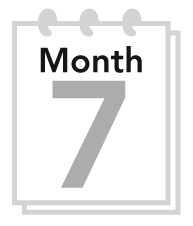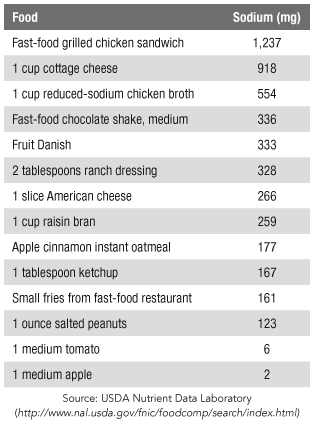
So far, we’ve covered calories, carbohydrates, and fats in depth. Sodium is the focus this month. You’ll understand why it can help to shake the salt habit, and you’ll learn sodium-trimming strategies for the grocery store and at home.
For the Long Haul: Be Sodium Savvy
Can you imagine that, centuries ago, salt was prized? Ancient Greeks used salt as currency, and Roman soldiers received it as part of their pay, giving us the word “salary.” No one considered the possibility of having too much sodium. The story today is quite different. According to the Dietary Guidelines for Americans, 2010, African Americans, anyone age 51 years and older, and anyone with diabetes, high blood pressure, or chronic kidney disease should consume no more than 1,500 mg of sodium each day. The American Diabetes Association suggests that anyone with hypertension should keep their sodium intake to less than 1,500 mg per day. The average intake among Americans, however, is more than double that at 3,400 mg per day! Most individuals who are not in the above categories should limit sodium to 2,300 mg per day, so it seems that nearly everyone consumes too much. A high sodium intake is linked to high blood pressure, excess calcium losses in the urine, increased symptoms of heartburn, stomach cancer, and other illnesses.
So where does all this sodium come from? As a point of reference, one teaspoon of salt contains 2,325 mg of sodium. Very little of our sodium intake comes from our saltshaker, however. Most comes from restaurants and packaged foods. Limiting salt in cooking and at the table will help some but is probably not enough. You’ll also need to read labels carefully (reminder: check the label for serving sizes first), seek out lower-sodium options, prepare more foods at home, fill up on vegetables and fruit, and request that restaurant chefs use little salt.
Don’t let a bland or sweet taste trick you into thinking a food is low in sodium. Could you guess that a fruit Danish has more than 2 ½ times the sodium of a small order of French fries?

Using Less Salt at Home
Leaving higher-sodium foods on the supermarket shelves and cooking with as little salt as possible are important strategies. The following tips will help you even more.
• Eat smaller portions of high-sodium foods.
• Prepare your own salad dressings. To make a basic vinaigrette, mix a favorite vinegar or citrus juice with extra-virgin olive oil and seasonings. Start with a ratio of two parts oil to one part vinegar or juice, and adjust to your taste. Perhaps the simplest vinaigrette is a mix of extra-virgin olive oil, lemon juice, garlic, salt, and pepper.
• Use only half the seasoning packet in rice mixes and other packaged foods. Better yet, prepare your rice dishes and casseroles from scratch.
• Rinse canned beans and other vegetables.
• Mix a can of regular vegetables or soup with a can of low-sodium vegetables or soup.
• In recipes for bread and other baked goods, reduce the salt by ¼ to ½.
• In other recipes, reduce the salt by at least half. In most cases, you can omit it completely. Instead, add pizzazz to your recipes with a splash of citrus juice or flavored vinegar. Experiment with herbs and spices, too. Try adding some of these herbs and spices to your dishes:
—Basil: cheese, chicken, eggs, Italian and Mediterranean cuisines, salads, salmon, tomatoes, watermelon, zucchini
—Cinnamon: bananas, blueberries, chicken, Middle Eastern and Moroccan cuisines
—Dill: carrots, cucumbers, eggs, fish, potatoes, salads, tomatoes
—Mint: carrots, cucumbers, honeydew melon, Middle Eastern cuisine, lamb, peas, salads
—Oregano: beef, bell peppers, chicken, eggs, fish, Greek, Italian and Mediterranean cuisines, mushrooms, shrimp, tomatoes
What changes in your health have you noticed these last several weeks? Has a recent laboratory report shown progress? Go back to your Progress Report to record all of your successes. Include how you feel, improvements in medical tests, and each new behavior that makes you proud.
 Continue the following goals: _____________________________________________________________
Continue the following goals: _____________________________________________________________